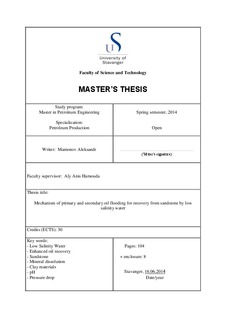| dc.contributor.author | Mamonov, Aleksandr | |
| dc.date.accessioned | 2014-09-22T12:35:20Z | |
| dc.date.available | 2014-09-22T12:35:20Z | |
| dc.date.issued | 2014-06-16 | |
| dc.identifier.uri | http://hdl.handle.net/11250/220914 | |
| dc.description | Master's thesis in Petroleum engineering | nb_NO |
| dc.description.abstract | Low salinity water flooding (LSW) as an enhanced oil recovery (EOR) method has been discussed by many researchers, but consistent approved mechanism is still not found. The main reason of lack of clear understanding of the process is complexity of the oil/brine/rock interactions. Therefore, theme of this project was chosen to study the mechanism(s) behind the low salinity EOR by flooding different brines through the sandstone cores and analyzing obtained data.
This thesis contains a literature review, experimental and discussion parts. Experiments were made for two different sandstone types (Bentheimer and Berea) and two different core lengths. LSW effects were studied as a primary injection fluid and secondary injection fluid - EOR (after flooding with synthetic sea water – SSW). Oil recovery and pressure drop across the core were detected and for effluent water samples were measured pH, ions concentration and amount of silicon/aluminum.
This work was made with the intention of improving the understanding of processes during flooding with low salinity brine. The idea was to study different sandstone types and define relationship between core length and amount of brine/rock interactions. Results showed that the main reason for improved oil recovery by using LSW brines can be the wettability changing of the rock surface. Possible underlying reason for this process is sandstone minerals dissolution, which was confirmed by increased amount of K+ in effluent water samples. pH of effluent water samples showed stably higher values than pH of influent LSW, which can be the consequence of minerals dissolution. Possible double layer expansion together with dissolution process could enhance particle detachment and increased pressure drop across the cores.
Based on obtained results, Berea sandstone has higher potential for LSW effects due to higher amount of brine/rock interactions and respectively higher oil recovery. Higher amount of K and Si was found in effluent samples for Berea type in compare with Bentheimer. Oil recovery measurements for long cores also showed higher values than for short cores, which tell us about the dependency of the results on the core length. | nb_NO |
| dc.language.iso | eng | nb_NO |
| dc.publisher | University of Stavanger, Norway | nb_NO |
| dc.rights | Attribution 3.0 Norway | * |
| dc.rights.uri | http://creativecommons.org/licenses/by/3.0/no/ | * |
| dc.subject | petroleumsteknologi | nb_NO |
| dc.subject | enhanced oil recovery | nb_NO |
| dc.subject | EOR | nb_NO |
| dc.subject | low salinity water flooding | nb_NO |
| dc.title | Mechanism of primary and secondary oil flooding for recovery from sandstone by low salinity water | nb_NO |
| dc.type | Master thesis | nb_NO |
| dc.subject.nsi | VDP::Technology: 500::Rock and petroleum disciplines: 510::Petroleum engineering: 512 | nb_NO |
| dc.source.pagenumber | 104 | nb_NO |

